Last updated: April 10, 2025
Article
Helping Managers Plan for Climate Change with Remote Sensing at Bryce Canyon National Park

NPS/Amy Washuta

NPS/Dana Witwicki
This raised some troubling questions. Should park managers expect more of the same in the future? Could pinyon and juniper trees in other areas be affected? Which other vegetation types might change—and when and where? And what, if anything, could be done about it?
If we had a crystal ball, how might our approach to management change?
We know long-term monitoring creates a record of the past. But it also provides a window into the future. Tracking which kinds of vegetation are changing, where they grow, and which aspects of climate are associated with the changes can help us understand what, when, where, and why future changes may occur, based on climate projections.
Linking satellite observations of vegetation condition with climate data over time can reveal how climate influences plant production (growth) and phenology (timing of growth). It can also tell us how sensitive different plant communities are to changes in weather and climate. With information like that, we won’t need a fortune teller.
To see how this might work, Northern Colorado Plateau Network scientists used satellite imagery to analyze vegetation condition over time at parks on the northern Colorado Plateau, including Bryce Canyon National Park, and explored the relationships between climate and vegetation using new tools for assessing climate effects. At Bryce Canyon, dramatic transitions in vegetation occur with increasing elevation, from lowland semi-arid shrublands to subalpine forests at Rainbow Point. Knowing which of the wide range of 15 vegetation assemblages (alliance groups) found in Bryce Canyon are more or less sensitive to climate change can help managers understand what to expect over the next few decades, and plan for the changes coming their way.
Phenology and Production
Satellite images collected over time show us when plant growth begins in spring (“greenup”)—because the landscape turns green. At the end of the season, it senesces and turns brown (“browndown”). Linking the timing of greenup and browndown to weather provides insight about how weather affects phenology.
At Bryce Canyon National Park, we used satellite imagery from remote sensing to track phenology and production across 15 vegetation alliance groups in and near the park from 2000 to 2019:
- Blue Spruce
- Bristlecone Pine
- Disturbed
- Douglas-fir
- Geology
- C3 Grassland
- Perennial Exotic Grassland
- Pinyon-Juniper
- Ponderosa Pine
- Dry Sagebrush
- Dry Shrubland
- Mixed Montane Shrubland
- Sparsely Vegetated
- Wet Meadow
- White Fir
Phenology
By the end of the study period, the growing season was starting 1.1 days later on average across all alliance groups and ending 12.1 days later. The length of the growing season was 10.1 days longer on average, and the day of peak growth was 6.8 days later.
Production
-
Annual trends in vegetation production between 2000 and 2019 were mostly stable, with only slight increases noted in a few alliance groups that represented only 3% of the study area (about 478 ha).
-
The greatest rates of increase in annual production occurred in the Perennial Exotic Grassland and Dry Shrubland alliance groups.
Climate Conditions
We used a water-balance model to determine how different aspects of climate and site characteristics affected vegetation phenology and production. From the time this study began in 2000 (during a very dry period) to its end in 2019, growing season primary production increased in most vegetation alliance groups in and near Bryce Canyon NP. This increase coincided with a slight increase in precipitation over the same stretch of time. However, there were also dry years during the study, and dry periods that lasted for several years, both of which resulted in substantial declines in vegetation cover. These declines largely rebounded by the time the study ended in 2019. There were also some large fires that reduced the vegetation cover in the White Fir alliance group in southern parts of the park. Taking the long view, an interesting decadal oscillation was evident: peaks in the middle of each decade since 1980 translated to similar peaks in other water-balance variables. If the periodicity of these cycles continues in the future, it could serve as a useful guide for timing restoration efforts that require substantial planning efforts, long-term investments, and multiple years of minimal drought stress for germination and establishment.
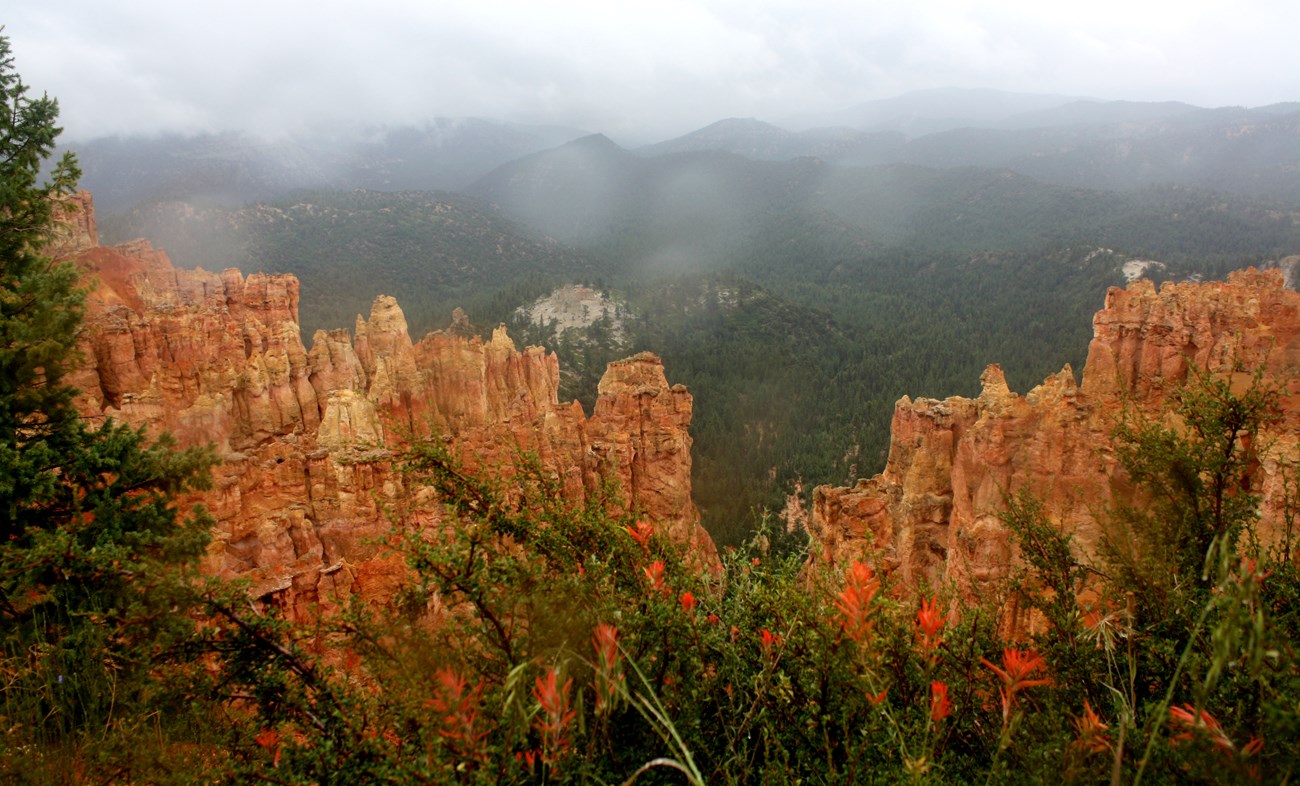
NPS/Amy Washuta
Relationships of Climate and Vegetation
With this information about phenology, production, and climate in hand, we explored which climate variables were the most important drivers of phenology and production, which vegetation types were most sensitive to changes in water availability, and which types were most resistant to drought.
Climate drivers of production and phenology
-
Annual growing-season production was most strongly correlated with annual average soil moisture and annual actual evapotranspiration from the previous one or two years, suggesting that increases in annual precipitation may have caused most of the increase in production over the study period. This was also generally true at the alliance-group scale.
-
The Wet Meadow, Perennial Exotic Grassland, and Dry Shrubland alliance groups required the highest average annual soil moisture to maintain production, whereas Bristlecone Pine, Disturbed, and White Fir alliance groups required the least average annual soil moisture to maintain production.
-
The primary determinants of the start of the growing season were growing degree days and precipitation.
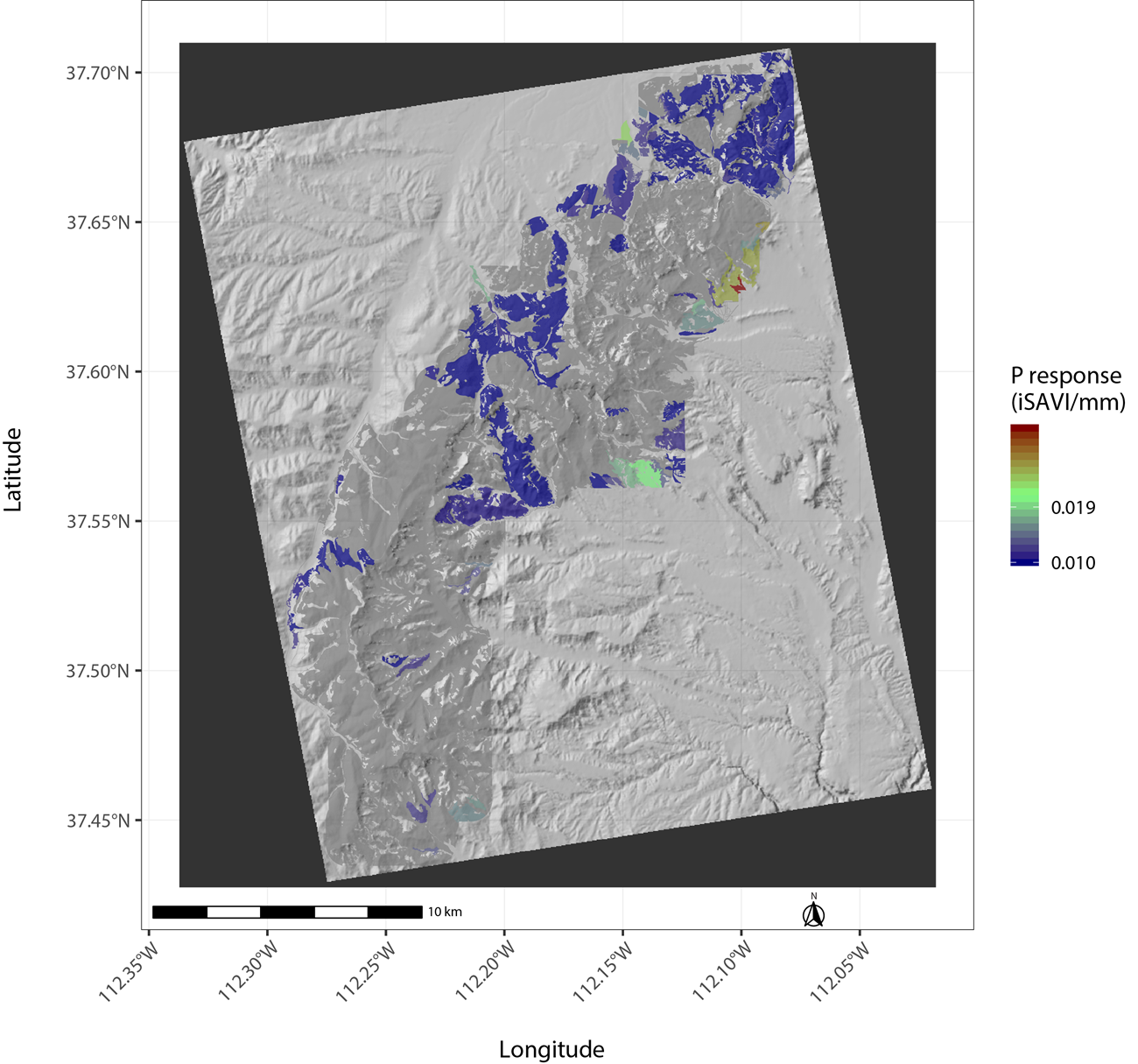
Vegetation sensitivity to climate
The way vegetation at Bryce Canyon National Park responds to various climate drivers reflects the different plant communities and the site conditions where they grow. The same amount of change in precipitation, for example, may cause different responses from different vegetation types, or even in the same vegetation type growing in different soils. The rate of change in vegetation condition per unit change in a climate variable is known as its climate sensitivity. More-sensitive vegetation types respond more quickly or more strongly to changes in climate conditions. Understanding a vegetation type’s climate sensitivity is critical to understanding its vulnerability to future climate change.
-
Vegetation types at Bryce Canyon National Park, ordered from MOST to LEAST sensitive to precipitation:
- Sparsely Vegetated
- Dry Shrubland
- C3 Grassland
- Wet Meadow
- Perennial Exotic Grassland
- Dry Sagebrush
- Pinyon-Juniper
- Geology
- Mixed Montane Shrubland
- Ponderosa Pine
- Blue Spruce
- Douglas-fir
- White Fir
- Bristlecone Pine
The Sparsely Vegetated, Dry Shrubland, and C3 Grassland alliance groups were most sensitive to water deficit and drought.
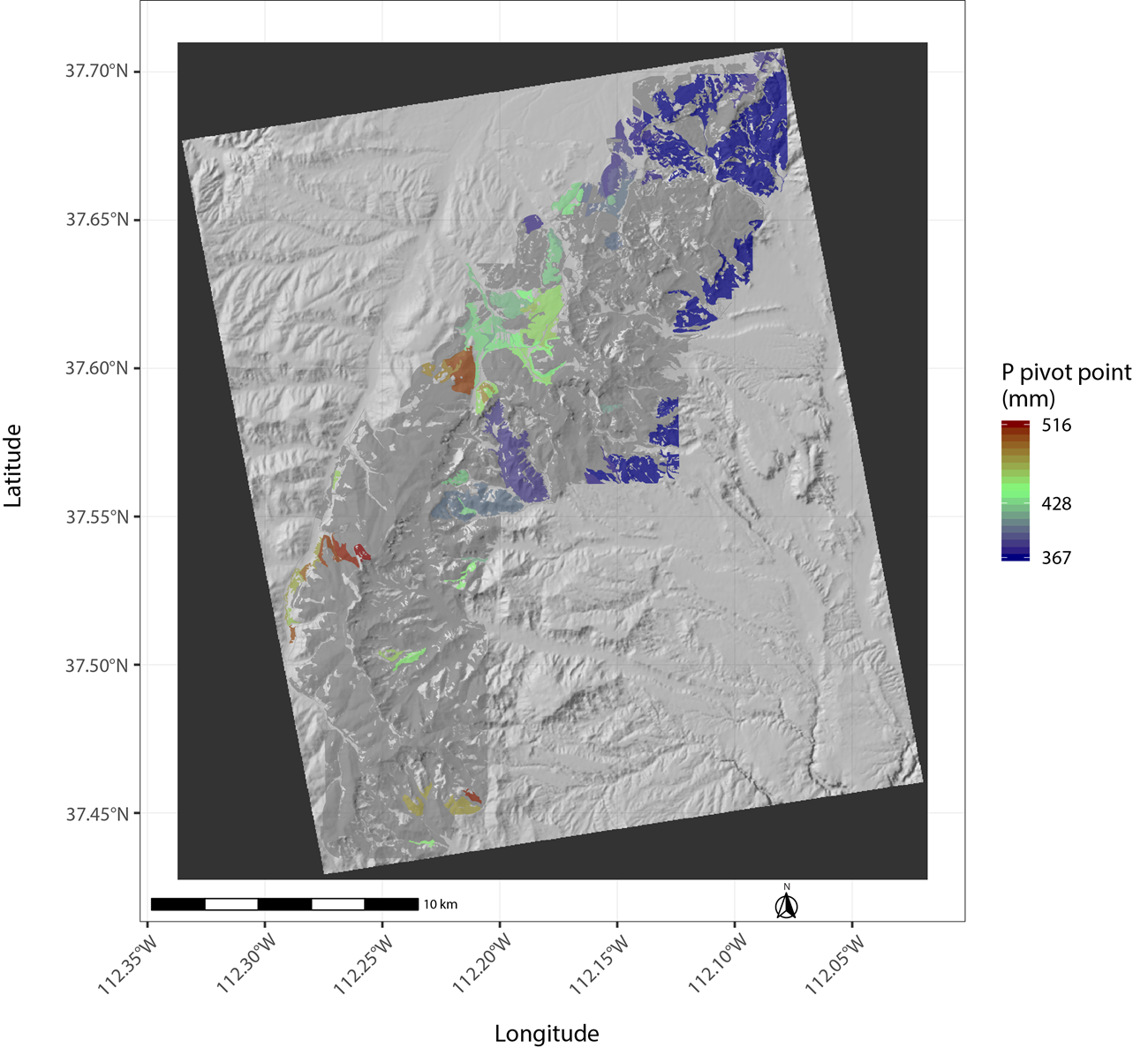
Drought tolerance
Understanding drought tolerance helps park managers determine which vegetation types may persist or perish if water stress increases due to climate change. Vegetation that requires less water is more drought-tolerant.
-
If the landscape gets drier, then the amount of area suitable for drought-tolerant species will likely increase. Under a drier scenario, there will likely be less area available for drought sensitive species.
-
Vegetation types at Bryce Canyon National Park, ordered from MOST to LEAST drought sensitive:
- Geology
- Sparsely Vegetated
- Bristlecone Pine
- Pinyon-Juniper
- Perennial Exotic Grassland
- C3 Grassland
- Mixed Montane Shrubland
- Ponderosa Pine
- Dry Sagebrush
- Douglas-fir
- Dry Shrubland
- Wet Meadow
- White Fir
- Blue Spruce

NPS/Amy Washuta
What Lies Ahead for Bryce Canyon National Park?
Potential vegetation transitions
Though our science-based findings are more reliable than the musings of a fortune teller, they have limits. We can’t know exactly how vegetation change will play out at Bryce Canyon National Park. But change is coming. The cause of juniper mortality seen by park managers in other parks in southern Utah in 2018 was acute drought stress (Kannenberg 2021)—a surprising finding, given the relative insensitivity of juniper to interannual precipitation changes. However, at Bryce Canyon National Park a range of scenarios indicate a trend toward more aridity in the future (see figure).
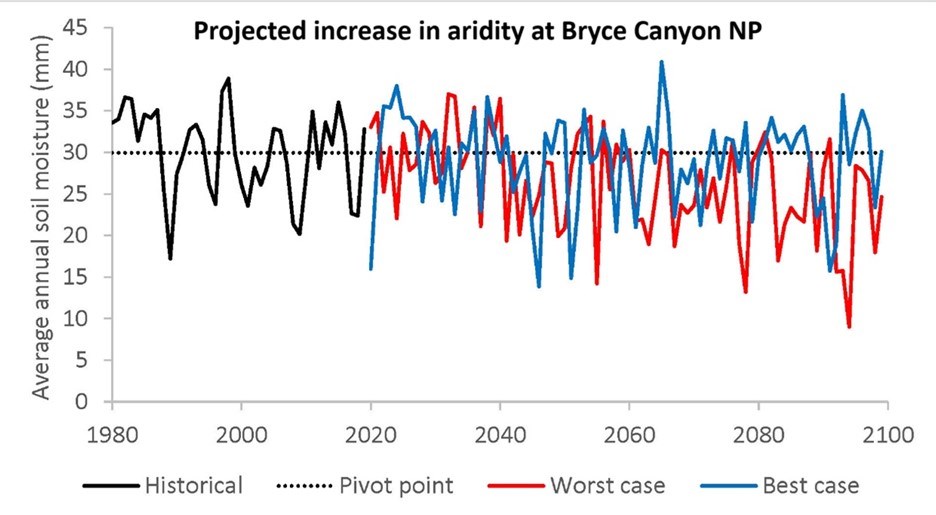
In the figure, “average annual soil moisture” represents the amount of moisture stored in the top meter of soil at a single Ponderosa Pine alliance group polygon at the park's center. The “pivot point” represents how much drought stress a vegetation type can tolerate and still persist over time. Soil moisture at levels below the pivot point restricts plant growth and survival. Combined with climate projections of increased aridity, the vegetation sensitivity to soil moisture reported in this study can help guide the time and place for management actions at Bryce Canyon National Park. Under the warm-and-wet (best-case) scenario, annual soil moisture will only achieve the historical soil moisture pivot point occasionally—meaning that even in the best case, soil moisture will not be sufficient to meet vegetation needs in this polygon. This will likely result in transition to a different vegetation assemblage due to drought stress, forest disease or fire. Under a worst-case (warm-and-dry) scenario, soil moisture will be lower than the best-case scenario in even more years. This will result in more intense and prolonged drought stress that will likely make transitions happen sooner. It may also result in more dry-adapted vegetation composition than in the best-case scenario. Either way, the time to start planning for change is now.
Informed planning
Managers can use information from studies like this one in a powerful planning framework. Planning for a Changing Climate is a roadmap for managing natural resources as the climate changes. Ultimately, this process helps managers decide whether to resist, accept, or direct vegetation change and identify management options for each approach. One of its key inputs is a resource’s sensitivity and vulnerability to climate change, which this study provides. The report associated with this web article offers a step-by-step application of this kind of information for climate adaptation planning.
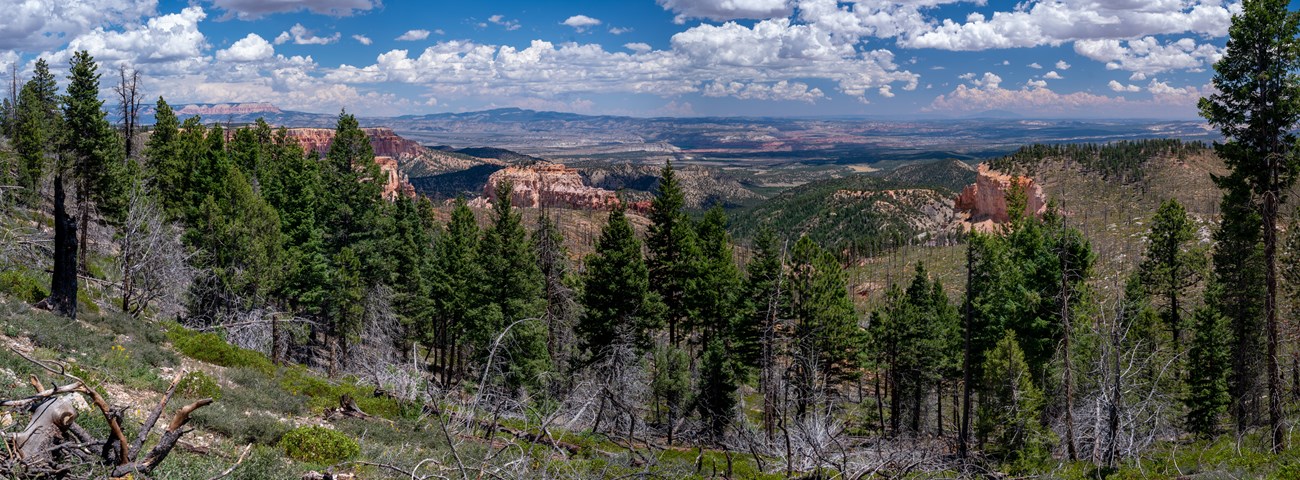
NPS
Information in the report can also be used to identify optimum restoration windows. Restoration projects are an indispensable resource-management tool. They are also expensive and time-consuming. If park managers can anticipate how different vegetation types are likely to respond to projected climate conditions, then they can adjust the species mix and timing of restoration projects to optimize seed germination and establishment of desirable species most likely to survive new climate conditions.
Other potential questions—and answers
The information provided in this research can also help managers anticipate and plan for cascading ecological effects, such as effects on pollinators, or the movement of wildlife (migrations) across park lands. It can also be leveraged to answer many more questions, such as:
-
Where are the most- and least-sensitive vegetation types in the park, and when might they experience chronic conditions that force change?
-
Are forests likely to experience drought stress or transition sooner than shrublands?
-
Which soil types most effectively buffer drought stress, and where do they occur in the park?
-
After disturbances, such as wildfire or extreme drought, are climate conditions likely to support historical vegetation types?
-
Are animal species of concern dependent on climate-sensitive vegetation types?
Vegetation provides valuable ecological services and adds to park viewsheds in immeasurable ways. But plants are sensitive to weather and climate—and when those conditions change, they respond. This report provides a foundation for understanding where, when, what, and why change may occur. Park managers can use that information to help manage park resources through continuous change.
Information in this article was summarized from Landscape phenology, vegetation condition, and relations with climate at Bryce Canyon National Park, 2000–2019, by D. Thoma (2024).
Other cited material includes:
Gangopadhyay, S., C.A. Woodhouse, G.J. McCabe, C.C. Routson, and D.M. Meko. 2022. Tree rings reveal unmatched 2nd century drought in the Colorado River Basin. Geophysical Research Letters, June 9. https://doi.org/10.1029/2022GL098781.
Kannenberg, S.A., A.W. Driscoll, D. Malesky, and W.R.L. Anderegg. 2021. Rapid and surprising dieback of Utah juniper in the southwestern USA due to acute drought stress. Forest Ecology and Management 480 (January 15):118639. https://doi.org/10.1016/j.foreco.2020.118639.
Tags
- bryce canyon national park
- inventory and monitoring division
- ncpn
- northern colorado plateau network
- climate change
- climate change adaptation
- climate science
- climate
- climate change impacts
- science
- research
- ecosystem monitoring
- monitoring
- management tool
- plants
- vegetation
- science and resource management
- science and research
- science and resources
- research studies
- sustainability
- water balance
- phenology
- phenology monitoring
- waterbalancecc
